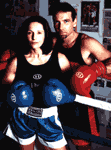BALAZS BOXING NEWSLETTER
January 2005

Happy New Year! Welcome to this installment of Balazs Boxing's newsletter. This month, Andy clues us in on what those announcers are talking about during a boxing match. Andy and Jamie also offer simple tips on how to keep up your fitness during travel. Lastly, in the "Ask the Trainer" section, the team gives advice to a young boxer who thinks it might be time for a professional trainer. The start of a new year is a great time to get focused on your fitness goals; get started today and be healthy!
The Balazs Team
Boxing Drill #14: Understanding Boxing Terminology
Boxing Terminology: Part 1
Whether you're a fitness boxer, competitive boxer or just enjoy watching a good bout on television, here are some basic boxing terms that you should know.
Defensive Moves:
Blocking
The most fundamental and defensive method is blocking. With your hands up and "tight," use the fist or outside portion of the gloves to block headshots. Use the elbow or forearm to block body punches. This technique works best against long, hooking shots.
Parrying
Parrying a punch involves "catching" it and then redirecting or pushing it aside. It works best against straight punches.
Usually, the right hand is used to defend against your opponent's jab and the left to defend against your opponent's right. This is a perfect time for a counter punch.
Slipping
Slipping a punch consists of bending at the waist and knees so that the oncoming punch slips safely past you. Effective slipping leaves both of your hands free for counterpunching and also leaves your opponent off balance.
A good defense can get boxers out of dangerous situations and even avoid them all together.
All of these defensive moves can be practiced while shadow boxing or working the Heavy Bag.
Boxers such as Evander Holyfield, Sugar Ray Leonard and Oscar De La Hoya, were known for their aggressive offence, as well as great defensive abilities.
Andy and Jamie's Health and Fitness Tip: Staying Fit During Travel
Traveling, whether for business or pleasure, does not necessarily mean throwing away all of your hard work in the gym. There are many options that will ensure your trip takes you closer towards your goals rather than farther away.
- Check with the hotel and ask about workout facilities in the hotel or nearby. There is no excuse if there is cardio and weight resistance equipment available.
- Remember to pack workout clothes and a good pair of running/walking shoes. A skip rope is also an excellent addition. It is light, packs easily and will give you a great workout!
- Drink plenty of water before you leave and during your plane flight. Being well hydrated assists the body to be less prone to jet lag, headaches, and water retention. Try to avoid alcohol and coffee on the plane as they both are dehydrating.
- Ensure to get adequate rest and sleep on your trip. Quite often poor food choices are made when you are tired, trying to get a quick fix.
- Remind yourself of your nutritional goals and continue to follow them when you are away. Of course, take the opportunity to take a break at times and enjoy what might be a less than healthy meal, but always go back to your healthy food choices.
- Take along your favorite healthy snacks. Often different hotels and cities will not carry the same brand of snacks and foods you like. Pack some and then when you get a craving you will not end up eating unfamiliar foods that may not necessarily satisfy you.
- When you arrive at your destination purchase fresh fruit, non-perishable food, and bottled water that you can keep in your hotel room. Once again, if healthy food choices are available, you won't need to visit the hotel vending machines.
- Schedule your workouts first thing in the morning, before your outings or meetings. You are likely to stay on track and meet both your fitness and nutritional goals all day if you start off on the right foot.
Keep up the hard work!
Ask the Trainer
"I am fifteen years old and going into the tenth grade. I weight lift every weekday under a strict program. I love boxing; in fact I myself have spent near a thousand dollars on boxing equipment for my home use, heavy bag, speed bag, jump rope, gloves and headsets, etc. However, I do not box at a gym and I have never been trained. I've learned what I know from the info that I read off of the internet and from books. My question to you is, should I continue training without the instruction of a professional trainer or should I stop because I could be forming bad technique and habits?"
There's nothing wrong with being 'self taught'. If you love boxing, there's no reason to stop your boxing workouts. It's always great to have the advice of an experienced boxing coach, but studying the fundamentals from a good boxing book or video can learn plenty. A great way to improve boxing form is to shadowbox in front of a mirror. This way you can work on proper technique, before you hit the heavy bag. Fitness is all about enjoying what you're doing, and you seem to love one of the hottest ways to stay fit on the planet.
- Andy Dumas
Send your questions for Andy to info@BalazsBoxing.com
Balazs Inc. publishes the "BALAZS BOXING E LETTER" monthly.
We hope you enjoyed receiving this mailing. However, if you would not like to be included in future Balazs Boxing mailings, please respond to this email with "remove" in the subject line.
Always consult your physician before starting any physical exercise program. Balazs Inc. and Andy & Jamie Dumas assume no responsibility for the improper use of information contained within this e-newsletter.
